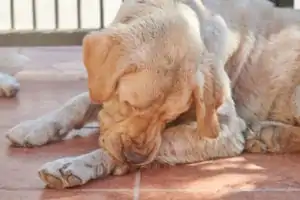Caring for and Preventing Hot Spots on Dogs
Does your dog have hot spots? Hot spots are an uncomfortable skin condition that can potentially affect any dog. They are more common during hot weather but can happen at any time. The official term for hot spots is acute moist dermatitis.

Excessive moisture on the skin in any one area can cause hot spots and can also cause them to worsen. One of the most common causes of hot spots on dogs is chewing or licking too much in one location. However, when the hot spot grows and starts to ooze and become painful, the dog may be more likely to lick it even more. Over time, the condition exacerbates itself in this way.
Learning how to care for hot spots can help you relieve your dog’s pain and discomfort. Curicyn offers a variety of products that are designed to help promote rapid healing for hot spots on dogs. Every product that Curicyn provides is safe for both you and your dog.
Understanding how to prevent this condition can also make a difference in your furry friend’s health and well-being. However, if you discover that your dog does have hot spots, Curicyn is here to help provide relief for your pet’s symptoms.
Causes and Symptoms of Hot Spots on Dogs
It can be hard to determine what caused your dog’s hot spots, let alone tell if they even have hot spots in the first place. Below are common causes and symptoms of hot spots on dogs.
Causes of Hot Spots
Although moisture is the most likely cause of hot spots, there may be other underlying problems that contribute to your dog’s excessive chewing and licking.
Some of the potential causes of hot spots on dogs include:
- Flea allergies
- Food allergies
- Dermatitis
- Parasites (fleas, ticks, etc.)
- Lick Granuloma
- Irritants that come into contact with the skin
- Infections of the skin or ears
- Dirty coat
- Matted fur
- Stress and boredom
- Swimming or bathing too often without drying thoroughly
These potential causes can lead your dog to start licking too much and they can also cause him to continue licking as the hot spots get worse. Regardless of what causes your dog’s hot spots, it’s important to find a way to care for them so they don’t spread. Not taking care of them right away can create a very serious case of hot spots all over the dog’s body.
Curicyn offers a Hot Spot Formula that is specifically designed to address the symptoms of hot spots on dogs. This is a non-toxic, antibiotic and steroid-free product that is completely safe to use on your pet. Not only does this formula promote rapid healing, but it also includes a proprietary ingredient that provides immediate relief, regenerates new cell growth, contains an anti-inflammatory, anti-itch, and a natural pain reliever. In addition, it aids in expediting the healing process.
Symptoms of Hot Spots
The most common symptom of hot spots on dogs is redness of the skin. The locations usually have defined edges and are often in round shapes (“spots”), but not always. The affected skin usually swells after the hot spot has been present for a while, and the dog’s hair may fall out in the area as well.
Hot spots ooze often and may also create pus. The spot may become flaky and crusty over time. The condition is very itchy and will cause your dog to scratch at the area often, which is likely to cause the sore to open up and bleed.
Caring for Hot Spots on Dogs
When you notice a new skin condition on your dog, talk to your vet for more information. The symptoms of hot spots on dogs mimic symptoms of other conditions in dogs, so it’s important to learn what the problem is before you understand how to care for it.
Shaving the Fur by the Hot Spots
If the sore does turn out to be hot spots, you may want to start by shaving or clipping the fur around the affected area. This may or may not be necessary.
Caring for the Infected Area
At Curicyn, our Original Wound and Skin Care Formula helps care for the area that’s infected with hot spots. This formula is designed with the sole purpose of expediting the healing process for skins conditions, including hot spots on dogs. When applied, this formula does not cause any burning, itching, staining or sensitivity for your pet.
Cleaning the Infected Area
It’s important to clean the area enough, but not too much. Too much cleaning will cause the area to become too moist and will actually make the condition worse over time. We recommend that you use Curicyn once or twice a day to clean the affected area.
Preventing Your Dog from Touching the Hot Spots
Finally, you may put your dog in a cone (Elizabethan collar) to keep him from scratching, licking, or chewing himself. This is usually the most uncomfortable part for the dog! However, when using Curicyn, you may not have to use a cone because it provides immediate relief.
To further aid the healing process for the infected area, Curicyn offers a Wound Care Clay that is designed to cover places that may be harder to bandage on your dog. This product covers the part of the skin on your dog that has the hot spots and helps prevent the area from getting any further infected. If you decide to use a cone for your pet, this clay can serve as an added source of protection for hot spots on dogs.
When cared for right away, hot spots on dogs can typically resolve in about three days. They may take up to a week to go away completely.
How to Prevent Hot Spots on Dogs
Ideally, you should try to prevent hot spots on dogs in the first place. And if your dog is prone to developing this condition, it’s even more important to make sure you do what you can to reduce his risk.
Maintain Good Hygiene
Hygiene is the most important factor in keeping your dog free from hot spots. You should have your dog groomed regularly. You can take him to a groomer or do this yourself at home.
Give him a bath at least once a month and keep his fur trimmed to a reasonable length. When you bathe him, check for hot spots on dogs. Make sure to dry him thoroughly after his baths.
Watch for Parasites
Pay attention to any parasites your dog may have as well. Continue to work with your vet to manage any allergies your dog may have. Allergies such as food intolerance can cause skin irritation in dogs.
To help prevent your dog from getting fleas, Curicyn offers a Bodyguard Flea, Tick and Insect Repellent that is designed to help keep your dog from getting fleas and a number of other parasites that can cause hot spots on dogs. This product is 100% safe to use on dogs and is safe to spray around humans, so you never have to worry about using this easily applicable product.
Keep Your Dog Occupied
Finally, if your dog has developed hot spots due to stress licking, walk him more often or play with him around the house to help him become less stressed. While you’re not at home, give him a treat or toy to work on.
Get Help for Hot Spots on Dogs
Now that you’ve taken the time to learn about how to prevent and care for hot spots on dogs, you should be better able to deal with the problem if it arises in your dog. You’ll know how to tackle the issue and what to do, and you’ll also know how to improve your dog’s well-being to reduce the chances of hot spots occurring again in the future.
Curicyn’s various products that can be used for hot spots on dogs all have one goal: to help accelerate the healing of your pet’s hot spots so they can continue living a comfortable and healthy life with you. Our products are all designed with the safety of your pet in mind as well as the convenience of using it for you. With Curicyn, you’ll never have to worry about how safe and reliable our products are for your dog.
All Curicyn Animal Wound Care products include a proprietary ingredient that provides immediate relief, regenerates new cell growth, contains an anti-inflammatory, anti-itch, and a natural pain reliever. In addition, it aids in expediting the healing process and gives the animal immediate relief.
Find a store near you that sells Curicyn.
If you do not see improvement within 3 to 5 days, it’s a good idea to get in touch with your vet. Your vet may then want to prescribe steroids and antibiotics.
